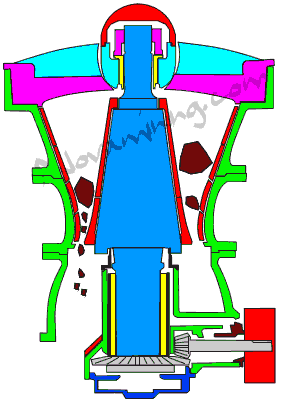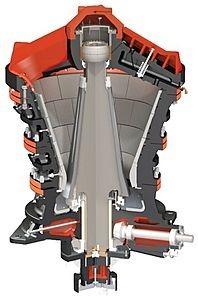Difference between revisions of "Gyratory Crushers"
| Line 1: | Line 1: | ||
[[Category:Particle Size Reduction]]{{Knoppen}} | [[Category:Particle Size Reduction]]{{Knoppen}} | ||
[[File:Gyratory_crusherGIF.gif|thumb|right|Gyratory Crusher principle]] | |||
[[File:Gyratory_crusherGIF.gif|thumb|right|Gyratory Crusher | |||
[[File:Gyratory_Crusher1.jpg|thumb|right|Gyratory Crusher]] | [[File:Gyratory_Crusher1.jpg|thumb|right|Gyratory Crusher]] | ||
[[File:Gyratory_Crusher2.jpg|thumb|right|Gyratory crusher, inside | [[File:Gyratory_Crusher2.jpg|thumb|right|Gyratory crusher, inside view]] | ||
A '''Gyratory Crusher''' is a large [[Crushers | crushing machinery]], using the gyratory sports in casing cone cavity of crushing cone to produce extrusion, fracturing and bending role to materials for crushing ore or rock of various hardness. Gyratory crusher is composed of transmission, engine base, eccentric bushing, crushing cone, center frame body, beams, original dynamic part, oil cylinder, pulley , appliances and dry oil, thin oil lubrication system components etc. | |||
A Gyratory [[Cone Crushers | Cone Crusher]] is one of the main types of primary crushers in a mine or ore processing plant. Gyratory cone crushers are designated in size either by the gape and mantle diameter or by the size of the receiving opening. Gyratory cone crushers can be used for primary or secondary crushing. The crushing action is caused by the closing of the gap between the mantle line (movable) mounted on the central vertical spindle and the concave liners (fixed) mounted on the main frame of the crusher. The gap is opened and closed by an eccentric on the bottom of the spindle that causes the central vertical spindle to gyrate. | |||
A | |||
==Principle== | ==Principle== | ||
A gyratory crusher is similar in basic concept to a jaw crusher, consisting of a concave surface and a conical head; both surfaces are typically lined with manganese steel surfaces. The inner cone has a slight circular movement, but does not rotate; the movement is generated by an eccentric arrangement. As with the jaw crusher, material travels downward between the two surfaces being progressively crushed until it is small enough to fall out through the gap between the two surfaces. | A gyratory crusher is similar in basic concept to a jaw crusher, consisting of a concave surface and a conical head; both surfaces are typically lined with manganese steel surfaces. The inner cone has a slight circular movement, but does not rotate; the movement is generated by an eccentric arrangement. As with the jaw crusher, material travels downward between the two surfaces being progressively crushed until it is small enough to fall out through the gap between the two surfaces. | ||
==Video== | |||
<youtube>EgBedKPTIq8</youtube> | <youtube>EgBedKPTIq8</youtube> | ||
Latest revision as of 06:01, 18 February 2013
A Gyratory Crusher is a large crushing machinery, using the gyratory sports in casing cone cavity of crushing cone to produce extrusion, fracturing and bending role to materials for crushing ore or rock of various hardness. Gyratory crusher is composed of transmission, engine base, eccentric bushing, crushing cone, center frame body, beams, original dynamic part, oil cylinder, pulley , appliances and dry oil, thin oil lubrication system components etc.
A Gyratory Cone Crusher is one of the main types of primary crushers in a mine or ore processing plant. Gyratory cone crushers are designated in size either by the gape and mantle diameter or by the size of the receiving opening. Gyratory cone crushers can be used for primary or secondary crushing. The crushing action is caused by the closing of the gap between the mantle line (movable) mounted on the central vertical spindle and the concave liners (fixed) mounted on the main frame of the crusher. The gap is opened and closed by an eccentric on the bottom of the spindle that causes the central vertical spindle to gyrate.
Principle
A gyratory crusher is similar in basic concept to a jaw crusher, consisting of a concave surface and a conical head; both surfaces are typically lined with manganese steel surfaces. The inner cone has a slight circular movement, but does not rotate; the movement is generated by an eccentric arrangement. As with the jaw crusher, material travels downward between the two surfaces being progressively crushed until it is small enough to fall out through the gap between the two surfaces.
Video


